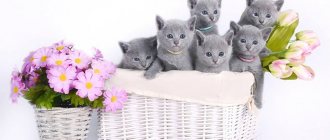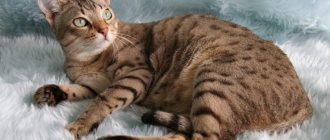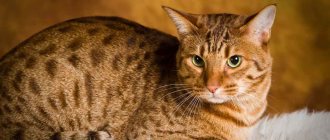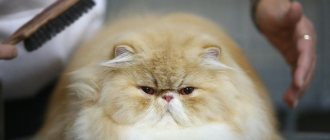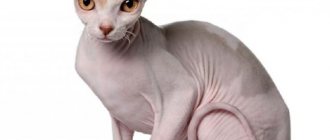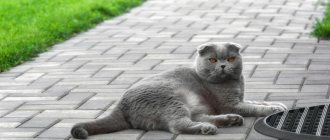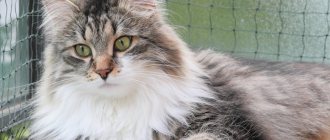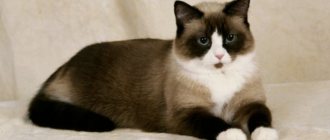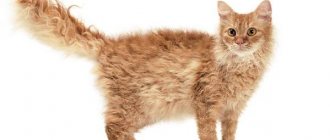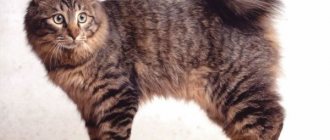Origin story
Karelian Bobtails are a native breed first discovered near Lake Ladoga.
Felinologists believe that their ancestors were the famous Norwegian cats - excellent hunters living in groups in the Karelian forests. For a long time they were considered relatives of the Kurilian Bobtail, but over time it became clear that from a genetic point of view, nothing connects them.
For the first time, Karelian bobtails were shown to the public at an exhibition in Leningrad, in 1987, at the request of the breeder Liliya Dvoryaninova. However, only in 1990 was a standard drawn up, and in 1994 they were officially included in the WCF register as one of the 3 officially recognized Russian breeds.
Character
Karelian Bobtails are very friendly and affectionate animals. They are kind and sensitive, love their home and owners. They don't force you when you're not in the mood. These cats are not too touchy, but rather easy-going and not vindictive. Most of all they are attracted by warmth and comfort, they adapt well to a new environment, as well as in communicating with new people, they love children. Relationships with other cats living in the house are quite friendly, since in the wild they are used to living in small groups.
The main distinguishing feature of Karelians is their amazingly thin and melodic voice. This peculiar sound is more reminiscent of chirping, for which German experts began to call them “Tweeting cats”.
True, it is very rare to hear their meows, because they are very taciturn. It is easier for them to approach and touch a person with their paw in order to attract attention. Karelian Bobtails are suitable for owners who do not like annoyingly meowing and overly sociable cats.
Standards
These are compact, small cats, with an average weight of 3-5 kg (males are larger than females).
| Standard | Description |
| Head | With a wedge-shaped skull and large erect ears. The forehead is flat. The whisker pads are barely noticeable, the chin is strong and narrow. |
| Eyes | Medium size, oval, slightly slanted. |
| Torso | The limbs are slender and muscular. Paws are round, wide, with graceful toes. The back is straight, the croup is slightly raised. |
| Tail | Short and always straight, from 4 to 15 cm long. |
| Wool | Thick, shiny, dense, short undercoat. Long-haired bobtails have “pants” growing in the area of their hind legs, and a shirtfront on their neck. Short-haired cats have neither shirt-fronts nor “pants”, but the fur is even thicker and more beautiful. |
A curved tail, a round head, an overly long or short body are a serious fault.
Cat with a short tail: application, characteristics of the breed
A cat with a short tail is a favorite of many owners. The short tail of representatives of Karelian bobtails was formed in the process of natural evolution.
The gene responsible for the length of the tail is dominant in this case (unlike the Kurilian bobtail).
Cats with short tails initially evoked pity among people. But later it turned out that they were born that way. There is a legend that if kittens with long tails were born in the offspring, the cat would gnaw off their tails, since in hunting they can only harm an adult.
The tail length of the Karelian Bobtail varies from 4 to 13 cm. There are straight and curved tails. Due to the fact that the hair on the tail is thick and long, it has the appearance of a fluffy pompom. The absence of a tail does not in any way affect the cat's quality of life or activity.
The Karelian Bobtail has a strong and proportionally built body. At first, the strong physique of such pets may lead to thoughts of clumsiness. But despite its impressive appearance, the Karelian Bobtail has exceptional agility and speed.
The cat has a flat, strong back and a developed chest. The paws are muscular and massive. Round pads allow you to step easily and softly on any surface, land from a height and climb trees.
Karelian Bobtail cats have a large triangular head with a large chin and round cheekbones. The ears, located at the edges of the head, have round ends and are decorated with tassels.
The cat has beautiful expressive eyes, the color harmonizing with the color of the coat.
See also: Selkirk Rex cat breed
According to international standards, chocolate and purple coat colors of the Karelian Bobtail are not allowed. Other colors are acceptable. Individuals in red, black and smoky gray colors look impressive.
The length of the coat is in most cases short to medium. Hair density is dense. The wool is soft and pleasant to the touch. The weight of an adult often reaches 7 kg.
The Karelian Bobtail is suitable for families with children. The cat's character is friendly, and there is no fear of aggression on his part towards the child.
Colors
Variety is allowed (including tricolor and bicolor). Exceptions: fawn, Siamese color, blue and brown shades.
In the photo there are cats of the Karelian Bobtail breed of popular colors
Since cats of this breed are bred only in nurseries, buying a Karelian Bobtail kitten is a difficult task. Why? Finding a nursery is not easy. This is not the most popular breed, which is why few individuals exist today, and they are quite expensive: a pet for the “soul” will cost you 35-40 thousand rubles, for breeding - 2 times more expensive.
When choosing a baby, be sure to look at his parents and ask to see the kitten’s passport. A small bobtail should be active, playful and not afraid of hands extended to him, with clean eyes and nose.
Description of Karelian Bobtails
global $ads_google;
//data-ad-slot=”2475549904″ $ads_google = empty($ads_google) ? false : true; ?> if ($ads_google == false) {?> $ads_google = true; ?> } ?> Representatives of the Karelian Bobtail breed
They create the impression of a large and graceful cat, whose external figure resembles a square geometric figure. The animal is of medium size, weighing from 4 to 7 kg, looks elegant and at the same time seems strong and robust. A special and obligatory feature of a bobtail is a very short tail, which looks perky and playful.
The breed standard prescribes the following appearance for animals:
- Small head
cats resembles an isosceles triangle. A flat forehead and high cheekbones go well with equally flat, non-protruding cheeks. The muzzle itself is narrow, the pads under the whiskers protrude somewhat. The nose is generally smooth and long. A sharp, strong chin completes the look;
- Oval eyes
Karelian Bobtail cats are placed somewhat askew, and are medium in size. The color of the eyes must be in harmony with the color of the fur coat; usually it is yellow or green, as well as any variations of these shades;
- Ears
may be large or medium, but will definitely be set high and straight. The ears are open forward. If you place a ruler down along the outer line of the ear, it will fit exactly past the line of the cheeks;
- Size body
medium, cats are muscular, but do not look massive, but rather sporty and graceful. The croup is straight and raised;
- Legs
The animal is very strong and proportional. The hind limbs are longer than the forelimbs. The paws are small, rounded;
- Wool
always with undercoat, dense, semi-long and very shiny. The villi are very close to the body, the undercoat is comparable to the length of the guard hair. There is a “collar”, “pants” and possible tassels on the ears;
- Tail
cats are very short, there may be a break, or some curvature, maximum length is 13 cm. The pubescence resembles a medium-sized pompom. The hair on the tail is elongated, it is the longest on the entire body;
- Color
could be anything. The exceptions are color point, Abyssinian, Burmese and chocolate lilac.
In addition to the advantages of appearance, there may also be disadvantages: a long body, a large head, an uncharacteristic muzzle shape, round cheekbones, straight-set eyes, a squat body, short legs and any other deviations from the standard. Possible birth of Karelian Bobtail kittens
with a tail length exceeding the norm.
Character and behavior
The Karelian bobtail is less popular than the Kuril or Japanese, and this is surprising: they are in no way inferior to their brothers in terms of docileness and tenderness of character. The Karelian Bobtail easily gets along in any family: both a large noisy one and a small one consisting of a couple or even one person. Cats immediately establish contact with all members of the family, generously showering affection on each one, but they choose one owner - usually the strongest one, in their opinion, and retain a special attachment to him until the end of their days.
If the owner is absent for a long time, they begin to miss him greatly, sometimes refusing both games and food, and when he returns, they run to greet him at the door, caressing him and “telling” how lonely they were.
Karelian Bobtails do not remember insults, they are patient and careful, so it is recommended to have these cats in a home where there are children. They can be left without fear even with very young children: bobtails will never allow themselves to bite or scare a child, but try to protect him from danger and even know how to call adults for help if they see that something wrong is going on with the child.
They are not intrusive and will not scream at the door at night, demanding attention. Their delicacy also does not allow them to wake up their owner at the crack of dawn, as many other cats do when they want to eat. Bobtails sit somewhere at a distance and patiently wait for the leader to wake up on his own.
According to folk wisdom, what should happen if a cat washes itself?
Receive a letter Guests will come
Karelian Bobtails have a very pleasant, gentle voice. Some compare it to the chirping of a bird. But these cats are not known for their inclination to talk, so the voice of a bobtail can be heard very rarely.
They get along well with other cats and even dogs. This is explained by the fact that in nature cats of this breed do not live alone, but in groups, so a group is familiar to them. They do not fight for territory or dominance, and males do not mark areas. At the same time, it clearly separates street and domestic animals, so your parrots and hamsters are out of danger.
At the same time, Kurilian Bobtails need time to be alone with themselves. If a cat has climbed onto the windowsill and is watching what is happening outside, do not try to cuddle him - he clearly will not like it.
He treats strangers calmly: he doesn’t shy away from them, doesn’t show aggression, but he’s not in a hurry to get into anyone’s arms.
They feel comfortable both in a private house and in an apartment, but they need their own playground for games. It is not necessary to sacrifice an entire room for this: it is enough to buy a small complex with several levels, stairs and tunnels.
Since bobtails have a very thick undercoat, they are not afraid of temperature changes, drafts and cold. Therefore, you can take them out for walks in the fall and even in winter. By the way, bobtails love fresh air and free space where they can frolic, climb trees and hunt for insects, mice and birds.
Characteristics of the Karelian Bobtail
From their ancestors, these cats inherited excellent hunting qualities: tracking, agility, flexibility, patience, vigilance, as well as guard qualities. All of the listed character traits can be observed with interest by the owner of a Karelian Bobtail.
. With great pleasure, the pet will walk around all the possessions and places accessible to it every day. Also, the pet can take on the duties of a living home alarm clock, and gently wake up household members by poking them with its paw.
An interesting feature is the lack of musicality of these animals. Their meow resembles a bird's chirping, very quiet and short-lived. Most likely, the cat herself will come up and bury her muzzle in the owner, rather than make a voice.
The Karelian Bobtail kittens will receive their owner's children with a bang - for them this is an opportunity to feel like full-fledged members of the family and be involved in interesting games. As the cat grows up, it will not become less active, it’s just that the periods of sleep and wakefulness will shift, and, most likely, your pet will be most active in the evening and partly at night, since the cat has not lost its wild forest blood. If children disturb the furry animal excessively, it will simply climb as high as possible to be out of reach.
It is very likely that the gentle pet will accompany the owner as he moves around the house. Will willingly sit next to a filled bath and may repeatedly dip its paws in the water. These cats love water, so they will not resist bathing.
Karelian Bobtail cat
loves to roam freely around the premises, so it’s worth thinking about walking. It’s great if such a curious cat lives in a private house and has regular access to the street. But in urban apartment living conditions, the owner should take care of the opportunity to let his cat roam freely.
It is worth adding to the positive character traits that this furry animal is unusually affectionate and loving, and knows how not to bother its owner.
Care instructions
Bobtail care is standard.
Wool
They need to be combed regularly: at least once a week. And during shedding - 3-4 times, using a brush with natural bristles or a rubber comb.
Bathing
Wash – once every 3-4 months, using a special shampoo for cats.
Eyes
The eyes are wiped every day, moistening a cotton pad with chlorhexidine, weak tea leaves or ordinary boiled water.
Ears
The ears are cleaned once a month, removing wax with a cotton swab.
Claws
If your cat uses a scratching post, you don't have to trim the claws. Otherwise, they should be trimmed every month with nail scissors or a nail clipper.
Karelian Bobtails are very clean cats. They know how to “make a mess” well even without human help. And, it’s worth noting, they are very squeamish. The tray will only be used if it is clean. If you are too lazy to remove the foul-smelling pile, the cat will do his best to show you your mistake.
Bobtails love to sleep well, so pay special attention to the location of the bed. Your pet must have its own separate sleeping place: preferably a house with a roof, where the animal can hide from everyone and have a good rest.
Features of care
Such pets are quite unpretentious and do not require complex care . The animals are in fairly good health. They can easily withstand harsh weather conditions and long trips. For your pet's comfort, you should know:
- Coat care consists of regular brushing a couple of times a week;
- Cleaning of ears and eyes should be thorough and regular;
- Cats quickly get used to the litter box.
- They don't mark territory;
- Cats of this breed are lovers of sleep and can sleep up to 18 hours. Therefore, create a cozy place for your pet to sleep;
- Karelians are most comfortable in private houses, because... they love walks around the yard;
- The pet is not picky about food, and it is good to eat specialized food and regular food. If you decide to feed your pet regular food, you need to provide it with proper and balanced food rich in proteins (low-fat meats, fish).
The Karelian Bobtail is a wonderful pet, endowed with a unique appearance and unique character, which does not require complex care.
Catering
Karelian Bobtails are unpretentious eaters and will obediently eat whatever their owner gives them. But this does not mean that they can be used as a garbage disposal and feed the leftovers of what you did not finish yourself. A cat's digestive system is very different from ours, and what we enjoy (like chocolate) will be deadly to a cat.
Natural products
A natural menu must satisfy the cat’s need for both basic and additional nutrients, and be safe (i.e., do not contain parasites or pathogenic bacteria, dyes, pesticides, hormones and GMOs).
80% of the diet consists of proteins, the rest - fats, carbohydrates, carbohydrates, fiber, micro- and macroelements, vitamins.
Menu includes:
- Lean raw or cooked meat (veal, beef, chicken, rabbit, turkey or lamb);
- Low-fat sea fish (flounder, hake, trout);
- Eggs: boiled chicken yolk, raw goose and quail;
- Dairy products (kefir, sour cream, cottage cheese, yogurt, natural yogurt, Varenets, hard unsalted cheese);
- Stewed vegetables (carrots, zucchini, pumpkin, asparagus, broccoli);
- Apples, greens, blueberries, cranberries;
- Vegetable oil (sunflower, olive, flaxseed);
- Porridge (oatmeal, semolina, pearl barley, rice, buckwheat).
You cannot give:
- Bones (both raw and cooked);
- Lard and fatty meat (pork, goose);
- Products with dyes and additives;
- Salty, smoked, pickled, sweet, sour, spicy;
- Mayonnaise, spices, seasonings, salt, sugar;
- Chocolate.
It is undesirable to give flour, baked goods, and whole cow's milk.
Babies are fed 6 times a day, kittens aged 3-4 months - 5 times, up to 6 months - 4 times, from 6 to six months - 3 times. Adult cats and cats - 2 times, in the mornings and evenings. An individual diet is provided for pregnant and lactating cats and animals weakened by age or illness.
Recommended food
Bobtails can be switched to ready-made food, both dry and wet, but remember: cheap does not mean good. Economy group food looks tempting, and cats usually eat them with great eagerness. But the bright packaging is deceiving; just look at the composition.
Flavor enhancers, dyes, corn gluten, meat waste (ground bones, fats, etc.), a minimum of healthy food additives and vitamins.
It is also not recommended to buy premium food: their composition is a little better, but they also cannot boast of a sufficient amount of nutrients. But super-premium and holistic food is a completely different matter. For their production, higher quality products, natural preservatives and a good vitamin and mineral supplement are used. Judging by reviews from breeders and consumers, the following are good foods:
Holistic: Farmina N&D, Go Natural, Wildcat;
Super-premium: Fitmin For Life, Leonardo, Vet Life.
Below are recommended super-premium foods. Links with the names of the food are clickable, on them you can, within our website, get acquainted with the descriptions of the food and read reviews from owners of Karelian Bobtail cats.
| Holistic | Holistic | Super premium |
| Canagan | Savarra | Airi |
The amount of food for a cat is calculated simply: 30-60 grams per 1 kilogram of live weight.
How to choose a Karelian Bobtail kitten
The Karelian Bobtail is not a popular breed, and the demand for it is not very high. This is due to the fact that representatives of the breed are quite difficult to buy. It is not easy to find a nursery where such cats are bred for sale in Russia. The cost of a kitten varies from 35 thousand rubles to 70.
In any case, when choosing a pet, you should pay attention to the activity and mobility of the baby. Examine the cat's eyes, nose and ears - they should be clean, without traces of discharge.
Ask the breeders for a passport and find out what vaccinations the cat was given and at what age. If possible, meet the kitten's parents to make sure you are getting a purebred.
Mating of Karelian bobtails is currently carried out exclusively in nurseries. The small number of the breed and low demand do not allow the mass breeding of such kittens. Males and cats older than 1-2 years are suitable for mating.
The Karelian Bobtail is a wonderful friendly cat breed. They can get along in any family, will not bother you with mischief and do not require special attention. Loyal pets with outstanding appearance and developed intelligence will become favorites of adults and children.
Diseases
Strong immunity and lack of genetic predisposition make this breed one of the healthiest. Under good conditions, a bobtail can live 20 years.
What is meant by good conditions? These are 3 points:
Timely vaccination and deworming
The vaccination schedule for all breeds is standard. Only clinically healthy cats can be vaccinated, which means that if the cat has signs of illness (diarrhea, vomiting, fever, lethargy, etc.) the procedure should be postponed.
Vaccinations are given against the following diseases:
- Rabies.
- Calcivirus.
- Rhinotracheitis.
- Chlamydia.
- Infectious peritonitis.
There are also vaccinations against parasites (fleas, ticks). They are made separately or in combination. Newborn kittens are protected by antibodies that enter their body through their mother's milk. But this immunity does not last long: when the kitten is 6 weeks old, it can already receive its first vaccinations.
Balanced diet
When choosing food for an animal, it is necessary to take into account its age, weight, activity, condition (pregnancy or the presence of chronic diseases) and gender. Cats should not be fed hot or cold food, but only comfortable food - lukewarm and always fresh. The same applies to water: you cannot give your cat water from the tap! It contains chlorine and other harmful compounds that are dangerous to the animal. You can either buy water in a store or purify it yourself (using a regular kitchen filter or standing in an open pan for several hours).
Walks in the open air
Cats benefit from walks in nature, be it a forest, a park, or their own plot of land. Karelian bobtails, which are especially active, absolutely need this.
Care and maintenance of the Karelian Bobtail
global $ads_google;
//data-ad-slot=”2475549904″ $ads_google = empty($ads_google) ? false : true; ?> if ($ads_google == false) {?> $ads_google = true; ?> } ?> A completely low-maintenance domestic cat. She will feel best if she can regularly be in the fresh air, where she can always hunt and climb trees to her heart's content. But most likely after such walks a Karelian bobtail cat
still have to bathe.
- Weekly bobtail care includes washing the eyes and ears with separate cotton pads.
- It will not be superfluous to have a cat’s oral hygiene, namely brushing its teeth. It is enough to do this action once a week.
- Once every few days such a rich forest coat with a thick undercoat will have to be combed out. It is better to accustom an animal to such a procedure from childhood.
Otherwise, care and maintenance do not present any difficulties.
Diseases of the Karelian bobtail breed
Fortunately, the pedigree of cats of this breed is impeccable in terms of health. As an inheritance from their ancestors, in addition to a wonderful tail, Karelian bobtails received strong immunity and resistance to many cat diseases, although they are not immune from them.
In order not to have to visit the veterinarian often, you should take into account two factors responsible for the health of your pet: walks in the fresh air and a balanced diet.
These furry creatures, Karelian bobtails, live for about 15 years.
Conclusions about Karelians
global $ads_google;
//data-ad-slot=”2475549904″ $ads_google = empty($ads_google) ? false : true; ?> if ($ads_google == false) {?> $ads_google = true; ?> } ?> To draw conclusions, it is worth considering step by step all the qualities of Karelian bobtails
:
- The first place is occupied by the excellent health of the animal. No worries;
- The affectionate and non-intrusive character of a pet can create an atmosphere of warmth and ease;
- The cat’s ability to get along with children and take part in their games;
- The funny appearance thanks to the fluffy pom-pom tail and the overall elegance of the breed are pleasing to the eye;
- Hassle-free maintenance and care will appeal to busy people.
Karelian Bobtail cats
- beautiful animals that will easily and simply enter the home and heart of their owner.
Photo gallery
Below are photos of cats of the Karelian Bobtail breed.
katalogporod
irena_adamovich
estamidea
aciebasie
Where can I buy
Since the breed is not very widespread in wide circles, people often do not even know where to buy a Karelian Bobtail.
It is better to do this from trusted breeders, even if the pedigree is not very important. This way you will be 100% sure that this is the breed in front of you. In addition, nurseries will give you detailed information on how to care for your pet.
If you see an advertisement on the Internet with a photo of a Karelian Bobtail at a low price, you should not rush to purchase. Most likely these are scammers.
History of Karelian Bobtail cats
According to a lot of historical information, representatives of this breed have been decorating the nature of our world since very ancient times. On the territory of the Republic of Karelia, along the coast of Lake Ladoga, which at that time was the only source of drinking water, a very large population of a wide variety of animals formed. Among them were amazing cats, with funny short tails. They lived and enjoyed life near a source of water and got along well with everyone around them. People living nearby did not interfere with the habitat of these purrs and the natural increase in their cat population. Moreover, such a neighborhood was beneficial to both parties. Cats received some “gifts” from humans in the form of food products, and they, in turn, thanked them for their good attitude by exterminating rodents, both on agricultural properties and in people’s homes.
According to the anatomical structure of the tail process, Karelian cats are similar to other examples of the cat world - Japanese Bobtails. Only in the case of the latter, the gene responsible for the short tail mutated in order to protect the animals from the violence of the Japanese, who believed that all troubles and adversities accumulated in the tails of cats and cut off this part of the body filled with evil. As for the Karelian bobtail, there is a version that they got this feature from nature so that the risk of injury to the tail process in a battle with other animals was reduced to a minimum; violence and superstition have nothing to do with it.
Representatives of this extraordinary breed of cats have aroused the interest of scientists for many years; scientists have repeatedly studied the genotype of Karelian aboriginal cats and reached a very fascinating conclusion, which is that the ancestor of this species is none other than the wild Norwegian cat (Norwegian Forest cat ).
So these short-tailed cats lived happily on the lands of their homeland, caught mice, and simply delighted the human eye. Such animals became one of the attractions of the coast of Lake Ladoga, but no one thought about somehow presenting them to official felinological organizations. Local residents are so accustomed to seeing cats with fur pom-poms instead of long tails that these purrs have simply become commonplace. But everything changed in the late 80s of the last century, when a cat breeder from St. Petersburg, Liliya Dvoryaninova, came to the Republic of Karelia. It was she who noticed the local cats and decided to introduce them to the world.
The “big appearance” for representatives of the Karelian Bobtail breed took place in 1987 at a prestigious exhibition in St. Petersburg. Of course, many people became interested in these not quite ordinary cats, but they did not evoke any special admiration. But the breeder did not give up. At the same time, a program was organized to improve the variety, and its preliminary standard was already planned.
A few years later, in 1994, Karelian Bobtails finally received their coveted recognition from members of the WCF (World Cat Federation) commission. But, unfortunately, their finest hour came to an end. This species was no longer recognized by any cat association, but even Russian cat lovers showed no particular interest in these animals. Who knows, maybe these cats are just not ready to bask in the rays of fame and popularity, and perhaps the day will come when the whole world will talk about the most beautiful pets from the Republic of Karelia.
Appearance standards
Cats feel comfortable both indoors and outdoors.
The appearance standard for the Karelian Bobtail was drawn up in 1990, and they were officially included in the WCF (World Cat Federation) register in 1994 as one of the three officially recognized Russian breeds.
Colors and coat type
Eye color harmonizes with color
Karelian Bobtails have a thick and shiny coat with a dense and short undercoat. The coat color can be almost any. The exceptions are colors such as color-point (Siamese color, when the color of the body is lighter than its protruding parts - head, paws, tail and ears), lilac-chocolate, Burmese (the same as the Siamese, but the “points” are darker ) and Abyssinian (there is no specific pattern on the fur, but light and dark areas are visible on each hair).
Anatomical features
The cat's tail itself is straight, and the bend and shape of the pompom is formed due to the fur.
Karelian bobtails are not large in size, but they cannot be called babies either. Males of this breed are larger than females, and the animal can weigh from three to five kilograms. The head shape of Karelian Bobtails is wedge-shaped, with medium-sized oval, slightly slanted eyes that are in harmony with the color of the coat. These cats have a flat forehead, a narrow and strong chin, and large and straight ears.
These tough guys love to hunt, but their size allows them to target mostly mice.
The tail of these cats is straight and short, reaching a length of no more than fifteen centimeters (minimum length is four centimeters). Karelian Bobtails have muscular and slender legs with round and wide paws. The pelvis is slightly higher than the level of the head.
Diseases of the Karelian bobtail breed
Karelian Bobtails are one of the healthiest breeds
Karelian Bobtails have good health, but this does not mean that preventive examinations, vaccinations and procedures should be neglected. This is especially true for those pets who spend a lot of time outside.
If a cat shows signs of any disease (diarrhea, vomiting, lethargy, etc.), the preventive vaccination should be rescheduled until the pet has recovered.
No hereditary or breed-specific diseases have been identified at this time. Nature has endowed these cats with excellent survival abilities, but improper care can ruin all this.
